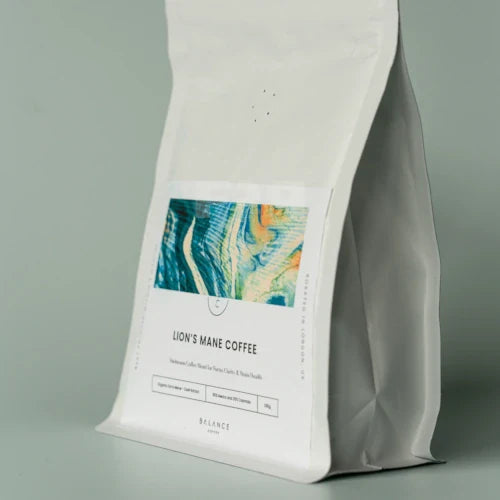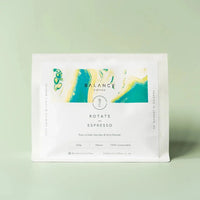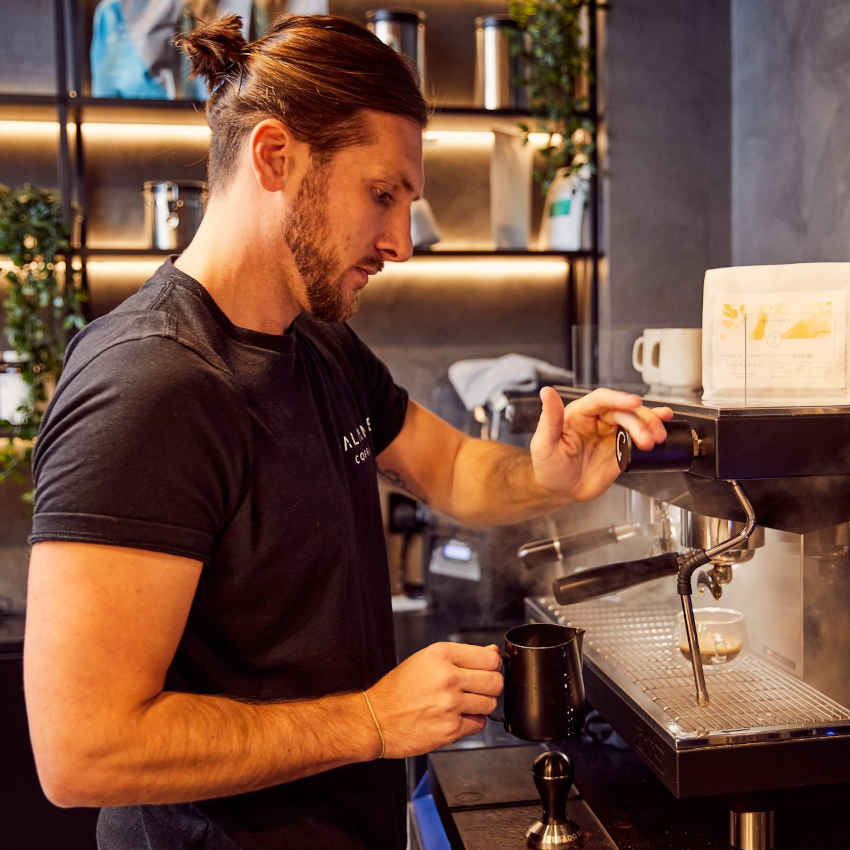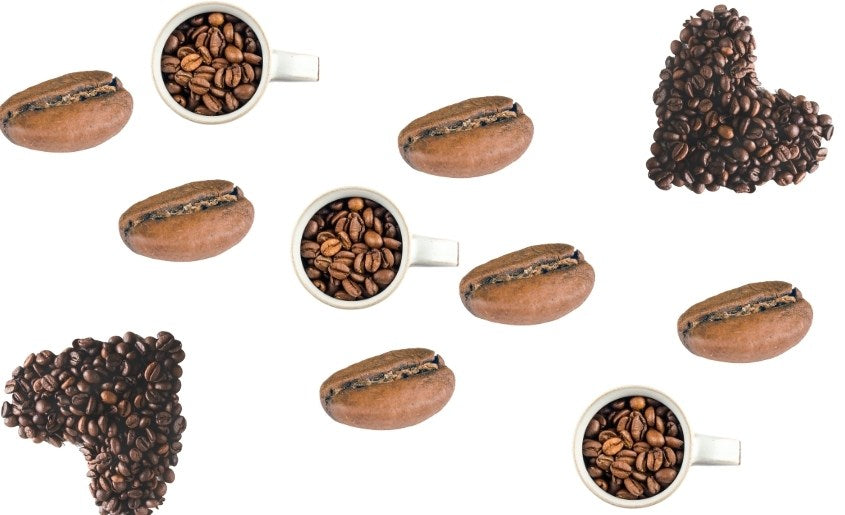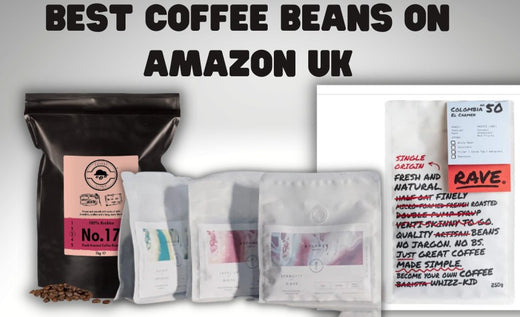So Peruvian coffee, what’s the whole fuzz about?
In today's post, I'll delve into the rich history of Peruvian coffee and explore where you can buy the finest beans. In addition, I'll introduce you to the unique flavours and what sets them apart.
You might be thinking, "Peruvian coffee? But, what's so special about it?" You'll never look back once you taste these beans. Because it is one of the best coffee beans in the world alongside Kona Coffee.

Peruvian coffee is the key that opens the door to coffee nirvana.
So, grab your favourite mug, and let's embark on this Peruvian coffee adventure together. It's going to be an interesting one!
Where to buy Peruvian Coffee Beans in the UK (Online Brands)
I've gone the extra mile, tasting loads of Peruvian coffee from different UK brands, to bring you this hand-picked list of the top 5 Peruvian coffee beans you can buy here.
Equally important, this wasn't just a random pick. I focused on two essential factors: the taste profile and the quality of the coffee.

It should interest you that I also used the above two criteria when I wrote the in-depth article best coffee beans UK. It is a fascinating piece, and I suggest you read it too.
Now that we've got that sorted let's dive straight into the list, shall we?
Assembly Coffee
Assembly Coffee is this smashing London-based coffee brand that's been turning heads since it first hit the scene. Established in 2015, they're all about bringing top-notch, ethically-sourced coffee to us lucky Brits.
The team behind Assembly Coffee is two passionate coffee lovers, Nick Mabey and Micheal Cleland. These guys are on a mission to create unique and memorable coffee experiences.

They work hand-in-hand with growers, ensuring their beans are delicious and making a positive difference.
Their commitment to quality and sustainability is spot on, so you're not just getting a smashing cuppa but also supporting good practices.
Their Peruvian gem, "Fidel Huancas," comes from Cajamarca in northern Peru.
It's got gorgeous notes of passionfruit, berry, and a silky texture, making it a fab choice for pour-over, filter, or espresso.
Lastly when you go for Assembly Coffee, you know you're in for a top-quality, ethically-sourced Peruvian coffee treat!
Volcano Coffee Works
Volcano Coffee Works is a fantastic London-based brand that's been making waves in the coffee world since it started in 2010.
Founded by Kiwi coffee expert Kurt Stewart, their mission is to bring the finest, ethically-sourced coffee to the UK.

Their team of coffee pros is dedicated to crafting delicious, sustainable brews that coffee lovers can truly appreciate. In addition, they work closely with farmers and cooperatives, ensuring that their coffee positively impacts crop to cup.
One thing that sets the brand apart is its small-batch roasting. They carefully roast their beans to bring out the best flavours, producing a top-quality, flavour-packed coffee.
They know that quality matters, and their dedication to sustainable practices means you can enjoy their brews without guilt.
Their Peruvian "Decaf Coffee" shows off their skills, using a chemical-free CO2 process to ditch the caffeine while keeping that lovely flavour intact.
With tempting notes of green grapes, maple syrup, and dark chocolate, it's a dream for decaf fans.
Their Easter Blend also mixes Brazil, Peru, and El Salvador beans, making it spot-on for anyone after a festive seasonal treat.
Rounton Coffee
Rounton Coffee is this fabulous coffee brand from North Yorkshire, named after the village it all started in.
Established in 2013, this coffee brand is committed to providing top-quality coffee. Their lovely coffee roastery is located in an old granary building, where they combine traditional and modern techniques to create sublime coffee.

Rounton Peruvian coffee is an absolute treat. The award-winning Sparkling Water Decaf Coffee from Peru has lush notes of caramelised brown sugar, cocoa, and a sweet cherry-like hint.
Another top choice is their "Daybreak Blend," which mixes beans from Guatemala and Peru, serving up rich dark chocolate and treacle flavours you'll love.
They have a range of blends and single-origin beans to suit any taste, and they even run a brilliant coffee subscription service.
Horsham Coffee Roaster
Horsham Coffee Roaster is another top-notch coffee brand based in Sussex, founded in 2012 by coffee lovers Bradley and Amelia. These chaps are passionate about creating coffee that'll make you smile.
Now, what's ace about Horsham Coffee Roaster is their dedication to transparent, responsible sourcing.

At their Sussex roastery, they roast their beans to perfection using a high-tech Loring roaster, which is eco-friendly and ensures consistently delicious coffee.
Their Peruvian coffee, "LA HIGUERA LOT 2," is sourced from the Colasay Project in the Colasay District of northern Peru. This coffee is a real treat, with savoury notes of apricot, peach, and milk chocolate.
You're getting a memorable Peruvian coffee experience and supporting a brand prioritising the planet's well-being and people.
Coffee Bean Shop
This brand is another excellent UK coffee brand that sells Peruvian coffee. Established in 2008, this family-run business takes pride in offering a fantastic selection of freshly roasted coffee beans from around the globe.
They are passionate about quality and only source the best beans from various origins. They roast them in small batches to ensure optimal freshness and flavour.

Now, let's talk about their Peruvian coffee option. Their Peruvian Tunki Coffee is a real treat for the taste buds, with its bright acidity, full body, and delightful notes of sweet chocolate, treacle, and lime.
The coffee is sourced from the Tambopata Valley, southern Peru, which has a reputation for producing some of the finest coffee in Peru.
What Is Peruvian Coffee?
This brilliant coffee comes from the lovely country of Peru, nestled right in the heart of South America.
Peru has the perfect mix of high altitude, diverse microclimates, and rich soil, making it the right spot to grow top-quality coffee beans.
The thing about Peruvian coffee is that it has a fantastic, well-balanced flavour profile. We're talking about fruity and floral notes, bright acidity, and a hint of nuttiness.

Some even say it's got a bit of a chocolatey sweetness to it, which I reckon makes it an absolute treat for the taste buds.
Peruvian coffee has been gaining quite a reputation lately, and for a good reason. It's produced in regions like Cajamarca, Chanchamayo, and Amazonas, each with unique characteristics.
Recommended For You: Kenya Coffee Ultimate Guide (History & Where To Buy)
I'll share more about this coffee's unique characteristics later in this guide. But for now, I'll tell you a few things about Peru's coffee history.
Peru Coffee History
Peruvian coffee production started in the mid-1700s, a bit earlier than many Central and South American countries.
Initially, it was mostly for local consumption, but things changed in the late 1800s. The Indonesian coffee industry was hit hard by disease, and European buyers needed alternatives.
In the early 1900s, the English spotted potential in the Peruvian coffee market and started setting up plantation-like farms.

But after the World Wars, England's Peruvian land was sold to local farmers. This gave them more control, but it also weakened the commercial systems.
They formed cooperatives with smaller farmers struggling to get their beans to market. By the 1970s, these cooperatives produced 80% of exported coffee. But the system wasn't perfect, and farmers often didn't see much export money.
There are over 110,000 coffee growers in Peru, mainly indigenous farmers living in native lands without basic amenities.
They cultivate shade-grown, top-quality Arabica beans and use micro-wet-milling, helping protect Peru's water resources from pollution caused by modern factories.
After processing their coffee, farmers travel to nearby markets on foot or by mule to sell their beans, usually to just one buyer.
The markets' remoteness and disorganisation mean that farmers often have to sell at low prices, and the unique quality of their coffee gets lost as beans are mixed and traded multiple times before reaching port cities.

Unfortunately, this resulted in the exploitation of farmers and their detachment from the final product. So, in response to these unfair trading practices, small cooperatives decided to join forces and create larger cooperative organisations.
Over the last decade, this consolidation has led to more organised business practices, helping producers connect with entities like Equal Exchange. The result? Better coffee prices, access to larger markets and buyers, and training for farmers.
Thanks to their efforts, small Peruvian cooperatives have become the second-largest supplier of Fair Trade coffee, right after Mexico.
Not only has this new system led to fairer trade, but it's also helped farmers produce higher-quality coffee beans. As a result, Peru has become one of the top third-wave coffee producers, focusing on organic and Rainforest Alliance certifications.
So now, they're not just making a difference in the lives of their farmers. They're also creating some seriously delicious coffee!
What Does Peruvian Coffee Taste Like
There's not much more to say about a taste praised by so many, but trust me on this: it's unlike anything you've ever had.
I know it might sound cliché, but it's genuinely true. Peruvian coffee taste has this mellow yet delightful taste that you'll love.
Now, like all great coffees, the ones from Peru come in various varieties, each with unique flavours, thanks to the minerals absorbed from the soil where they're grown.

Peruvian coffee typically has a medium body, which sits between watery and syrupy if you're unfamiliar with coffee lingo.
Just to give you an idea, Mexican coffee, which is grown at lower altitudes, often has a lighter body, while Sumatran coffee has a heavier, syrupy mouthfeel due to the nutrients in its soil.
Coffee experts, or "cuppers," describe the Peruvian coffee bean profile as aromatic and full of flavour, with mild acidity.
And when I say "flavourful," I am not talking about artificial additives, but I am referring to the natural flavours the beans pick up from the soil where they are grown.
Furthermore, with Peruvian coffee, your taste buds will enjoy nutty, chocolatey notes and even a hint of citrus while sipping it. The aroma and aftertaste are enough to keep you wanting more..
Most Popular Peruvian Coffee Growing Regions?
You know, in Peru, there are several regions dedicated to agriculture and farming, with coffee being a major export crop.
Some of the prominent coffee-growing areas are in the eastern part of the country and the southern highlands.
The Andes, Chanchamayo, Amazonas, San Martin, and the Southern Highlands are key regions.
-
ANDES
The Andes, the world's largest continental mountain range, boasts vibrant environments and agricultural areas.
When it comes to coffee, this region produces some of the most flavourful beans you'll find in Peru.
Many beans come from smaller farms, about 2-3 hectares, grown at elevations ranging from 3,200 to 6,000 feet.
-
CHANCHAMAYO
Nestled in the heart of Peru, the Chanchamayo Valley is known for producing some of the country's highest-quality beans.
This fertile valley, surrounded by the Andes Mountains, sees farmers planting beans at around 5,000 feet.
The coffee from this region is typically light to medium-bodied, with flavour hints of chocolate, nuts, and fruity citrus.
-
AMAZONAS
The high-altitude Amazonas region is located in northern Peru and is perfect for growing coffee beans.
With elevations between 5,700 and 6,500 feet above sea level, beans from this area have notes of citrus and berries, a creamy body, and a slight chocolate finish.
-
SAN MARTIN
The San Martin region, also situated in the northern highlands of Peru, is the third-largest coffee-growing area in the country.
Encompassing the Huallaga River, the Andean Plateau, and numerous hills and ravines, this region has an organic agricultural climate.
This is due to the lack of running water and chemical or mechanical influences. Nevertheless, it continues to grow each year, expanding its coffee production.
-
SOUTHERN HIGHLANDS
The Southern Highlands, accounting for about 23% of Peru's total coffee production, provide a healthy climate for coffee plants due to their high elevation.
Many farmers here tend to their crops by hand, nurturing their beans from the moment they're planted until they're ready for export, ensuring they’re of the highest possible quality.
Characteristics Of Peruvian Coffee
The diverse coffee-growing regions in Peru are broadly divided into three areas: North, Central, and South.
Each region has unique characteristics due to varying altitudes, climates, and conditions, resulting in distinct bean flavours.

Northern Peru is home to several essential coffee-growing regions:
- Piura: Expect chocolate, caramel, and nutty flavours from Caturra, Catimor, and Typica beans grown here.
- Cajamarca: This region produces sweet and acidic coffees from Caturra, Typica, and Bourbon varieties.
- Cutervo: It's known for notes of vanilla and molasses. This region grows Catimor, Pache, Bourbon, Typica, and Pacamara beans.
- Amazonas: Fruity and sweet profiles come from Caturra, Catimor, and Typica varieties.
- San Martin: With nutty and chocolatey notes, this region is similar to Amazonas and produces a lot of coffee despite its low elevation.
Now, let's explore the central coffee-growing regions of Peru:
- Huánuco: This region grows Caturra, Catimor, and Typica beans, which are known for their orange and caramel notes.
- Pasco: With a low production due to climate, coffee from this area has notes of citrus, floral, and fruit.
- Junin: Fruity, creamy, and acidic flavours come from the Caturra, Catimor, and Typica varieties grown here.
Lastly, I have the coffee-growing regions of Southern Peru:
- Cuzco: The climate is perfect for producing high-quality Caturra, Typica, and Bourbon beans with chocolate and fruity notes.
- Ayacucho: A newer region that grows Caturra and Typica beans, it offers flavours of chocolate, cereals, black fruits, and caramels.
- Puno: This area cultivates Caturra, Typica, and Bourbon coffee bean varieties, known for high quality but low quantity.
As you can see, each region has different characteristics contributing to Peruvian coffee's rich tapestry.
Recommended Brew Methods for Peruvian Coffee
Okay, let's talk about how to brew the perfect cup of Peruvian coffee. With their vibrant yet gentle flavours, Peruvian beans are incredibly versatile in brewing.
I recommend a few brewing methods to bring out the best in your Peruvian coffee.
French Press
Fancy a rich, saturated cup of coffee? The French press is an excellent choice. It uses an immersion process where coffee grounds and hot water mix, extracting the most flavour possible. Opt for a coarser grind size if you're grinding your own beans.
I have written extensively in the French Press Guide here and you can also check out my article on the best coffee beans for cafetiere or the french press here.
Pour-Over
If you love pour-over coffee, high-quality Peruvian coffee is one of the best coffee beans for pour-over. Many baristas adore the pour-over brew method because it offers manual control over the brewing process.
The "blooming" of the coffee releases all those fruity, chocolatey, and nutty notes hidden within the grounds.
Espresso
Craving an espresso that's bursting with flavour? Peruvian coffee is vetted as one of the best coffee beans for espresso.
For espresso brewing, you could use a burr coffee grinder to grind your Peruvian beans to a finer size.
This allows the hot water forced through your espresso machine's portafilter to extract all the flavour needed for a sharp, strong Peruvian espresso.
Aeropress
If you're the adventurous type and enjoy a bit of experimentation, the Aeropress might just become your new favourite.
It's a fun and versatile brewing method that lets you tinker with various elements like grind size, water temperature, and brewing time to create your ideal cuppa.

What I love about the Aeropress is that it allows you to explore Peruvian beans' entire spectrum of flavours truly. So every tweak you make to your brewing process could reveal a new, delightful taste sensation.
Traditional Peruvian Coffee
I understand this sound's new to some of us. But, hey, there was no way I could leave Peru's traditional brewing style out of the picture.
So, whether you're a coffee lover travelling to Peru or just want to experiment with traditional Peruvian coffee at home, it's good to know about the two main styles: café and pasado.
These speciality drinks offer a unique and authentic taste of Peruvian coffee culture.
Café
Picture yourself in a bustling marketplace or a cosy local restaurant in Peru. Chances are, you'll see many locals enjoying a simple yet flavourful drink called café.
You'll probably receive a cup of hot water and a serving of instant coffee in a restaurant. The thing is, Peruvian beans are so flavourful that they're typically just combined with water and enjoyed unfiltered.
Pasado (Cold Brew)
Fancy a refreshing Peruvian cold brew? Pasado is brewed for up to 12 hours, often in a closed jar. Then give it a good stir and shake it to make sure the grounds are fully saturated. It's a lovely way to enjoy Peruvian coffee on a warm day.
Pasado (Short Brewed)
Short on time? The short-brewed version of pasado is for you. Boiled water is filtered very slowly through coffee grounds, creating a powerful concentrate.
You can enjoy it as it is or mix it up with other liquids. This quicker method still captures the essence of Peruvian coffee in a delicious and invigorating way.
How Is Peruvian Coffee Grown
Peruvian coffee is mainly grown at soaring heights, between 3,200 and 6,000 feet, by small-scale, fair-trade cooperatives of coffee farmers who have a soft spot for organic methods.
They mostly use wet-processing techniques, fermenting the beans to bring out those delightful flavour profiles and subtle tasting notes.

As it turns out, Peru has climbed to the top as one of the world's leading producers of fair-trade coffee thanks to the birth of these cooperatives.
Take CENFROCAFE, for instance. It's one of the largest cooperatives, with more than 80 farm associations under its wing.
Established in 1999, CENFROCAFE offers technical assistance, quality control, and support for commercial endeavours. They're seen as a trailblazer in forging cooperative alliances with similar-minded associations.
Let me tell you about this fascinating trend recently gaining popularity: kopi luwak. It involves coatis or uchunari (cute little animals) eating Peru's highest-quality coffee cherries.
These cherries then journey through the animal's digestive system and come out the other end (yes, as poop!).
Don't worry; they're gathered and thoroughly washed. The magic lies in the animal's digestion process, which reduces the coffee's bitterness and introduces new flavours based on the creature's diet.
Intriguing, isn't it? But that’s not all, Let me walk you through how coffee from peru are harvested. Let’s dive in.
How Is Peruvian Coffee Harvested
It's quite the journey. In Peru, coffee is mostly grown in remote, high-altitude areas, and the harvest usually takes place between March and September.
The timing depends on factors like the region, altitude, and the specific microclimate of the area. Then, imagine the breathtaking scenery: small coffee farms nestled among the hills and mountains, often far from any roads.

Here, most of the coffee is hand-picked by skilled workers who know when to pluck the cherries at their ripest. This helps ensure that only the highest quality beans are selected for processing.
Once the cherries are picked, they're typically processed using the wet method. This involves removing the skin and pulp, leaving the beans surrounded by a sticky mucilage layer.
The beans are soaked in water, allowing fermentation to break down the mucilage. After that, the beans are washed clean, and it's time for them to dry in the sun, usually on raised beds or patios.

The drying process is vital, as it can significantly impact the flavour of the final cup. So, farmers keep a close eye on the beans and make sure they're turned regularly for even drying.
When the beans have reached the right moisture level, they're sent off to be milled. The parchment layer is removed and sorted by size, shape, and density.
Once that is done, it goes through the speciality coffee grading system upon shipping and landing in the UK, ceasing it as consumable.
Only then are they ready for roasting and brewing into that delicious cup of speciality coffee we all love.
How To Buy Peruvian Coffee
First and foremost, it's always a great idea to check out local independent coffee shops and roasters. These gems often source their beans from various regions, including Peru, and roast them in-house.
They usually have knowledgeable staff to help you pick the perfect blend or single-origin coffee for your taste buds. Supporting local businesses is a brilliant way to contribute to the community.
If you prefer to browse online, you're in luck! There are some online shops where you can find top-notch Peruvian coffee.

As I've mentioned, some of the best Peruvian coffee brands in the UK are Rounton coffee, Assembly coffee, and Volcano Coffee works.
While buying Peruvian coffee, watch for Fair Trade and organic certifications. These labels will help ensure you're buying delicious coffee that supports sustainable and ethical farming practices.
Once you've found your perfect Peruvian coffee, store them in some of the best coffee containers in the UK, away from direct sunlight, to keep them fresh and flavoured.
Peruvian Coffee Statistics & Facts
As we've been discussing Peruvian coffee beans, I realise there's much more to discover about this wonderful industry. So let me share some intriguing Peruvian coffee export statistics and facts you might find interesting.
- Peru has nine major coffee-growing regions: Amazonas, Cusco, Huanaco, Ayacucho, Junin, Villa Rica, Cusco, Pura, and Cajamarca. Each region has its unique characteristics and flavours.
- The average farm size in Peru is quite small, at just 3 hectares. It'sNevertheless, it's quite a tight-knit community of farmers.
- Regarding exports, Peru sends over 4.2 million bags of coffee abroad yearly, weighing a hefty 69 kg.
- The coffee industry is vital to Peru's economy, accounting for about 25% of the country's agricultural income.
- With over 110,000 coffee farmers in Peru, it's a widespread trade, and many of these farmers are part of cooperative societies. As a result, Peru is one of the leading fair-trade coffee distributors in the world.
- Peru contributes about 2% of the world's coffee supply, coming from its majestic mountains. It currently ranks as the 9th largest exporter of coffee and the 5th largest exporter of Arabica.
- Interestingly, despite relying heavily on coffee exports, local consumption in Peru is relatively low. On average, only 1 kilo of coffee beans is consumed per person each year, meaning most of their coffee production is destined for international markets.
Frequently Asked Questions
I realise that throughout this guide, I've shared loads of information with you, and it's only natural for some questions to pop into your mind.
So if you've any queries, please leave them in the comment, and I'll do my best to help you.
But for now, I've compiled some of the most frequently asked questions that fellow coffee enthusiasts like yourself have asked me about Peruvian coffee.
Is Peruvian coffee roasted light or dark?
Peruvian coffee roasting varies, from light to dark, depending on desired flavour profiles and individual preferences. For example, some prefer a lighter roast to highlight fruity and floral notes, while others prefer a darker roast to emphasise chocolate and caramel flavours.
Is Peruvian coffee low acid?
Generally, Peruvian coffee has a lower acidity level compared to other varieties. This is because the growing high-altitude conditions in Peru contribute to the bean's distinct flavour and lower acidity. However, specific acidity levels may vary depending on the bean variety and processing methods.
How much coffee does Peru produce?
Annually, Peru produces about 4.2 million bags of coffee, with each bag weighing 69 kg. This considerable output makes Peru a vital contributor to the worldwide coffee industry, with their focus on quality, sustainability, and fair trade practices.
Is Peruvian Coffee Arabica or Robusta?
Peruvian coffee predominantly consists of Arabica beans, known for their smooth, complex flavours and higher quality. Robusta beans are less common in Peru, as the country's growing regions are more suited to cultivating Arabica varieties.
Is Peruvian coffee stronger than regular coffee?
The strength of Peruvian coffee depends on factors like roast level, brewing method, and bean variety. Generally, Peruvian coffee offers a balanced and complex flavour profile, which may not necessarily be considered stronger than other coffees.
Is Peruvian coffee hand-picked?
Most Peruvian coffee is hand-picked, as most farms are small and situated in challenging, mountainous terrain. This makes mechanised harvesting difficult, leading to traditional hand-picking methods that can contribute to higher-quality coffee.
Is Peruvian Coffee dark roast?
Peruvian coffee can be dark roasted, but the roasting level ultimately depends on individual preferences and desired flavours. For example, dark roasting may bring out specific flavour characteristics like chocolate, caramel, or nutty notes, while lighter roasts may highlight fruity and floral qualities.
Where does Peruvian coffee come from?
Peruvian coffee comes from several growing regions, including Amazonas, Cusco, Huanaco, Ayacucho, Junin, Villa Rica, Cusco, Pura, and Cajamarca. Each region offers unique growing conditions and contributes to the diverse flavours found in Peruvian coffee.
Why is Peruvian coffee famous?
Peruvian coffee is renowned for its diverse and complex flavours, high quality, and commitment to fair trade practices. Peru is one of the world's top fair trade coffee distributors, ensuring farmers receive fair compensation and support sustainable growing practices.
Where is Peruvian coffee grown?
Peruvian coffee is cultivated across numerous regions, including Amazonas, Cusco, Huanaco, Ayacucho, Junin, Villa Rica, Cusco, Pura, and Cajamarca. Each region offers distinct growing conditions and contributes to the variety of flavours found in Peruvian coffee.
Does Peruvian coffee have caffeine?
Yes, Peruvian coffee contains caffeine, as it primarily consists of Arabica beans. Arabica beans naturally contain caffeine, making Peruvian coffee a source of this stimulant, just like other coffee varieties.
How much caffeine is in Peruvian coffee?
The caffeine content in Peruvian coffee may vary based on factors like bean variety and brewing method. However, on average, a cup of Peru coffee contains between 80-120 mg of caffeine, similar to that found in other Arabica-based coffees.
Is Peruvian coffee good for you?
Peruvian coffee can offer potential health benefits when consumed in moderation like other coffee types. These benefits may include antioxidants, improved cognitive function, and increased alertness. However, excessive consumption may lead to adverse effects like sleep disturbances, increased heart rate, or anxiety.
Conclusion
Well, folks, we've reached the end of our journey exploring the fascinating world of Peruvian coffee.
I hope you've gained valuable insights into these delightful beans' unique flavours, growing regions, and characteristics.
It's clear that Peru offers something truly special when it comes to coffee, and there's no better way to experience it than by trying it yourself.
While we don't currently offer Peruvian coffee in our selection (it's definitely on our bucket list!), our coffee subscription is still the best way to enjoy the finest coffee beans in the UK.
By plugging into the best coffee subscription in the UK, you'll embark on a taste adventure, discovering incredible coffees from other regions that excite your palate.


